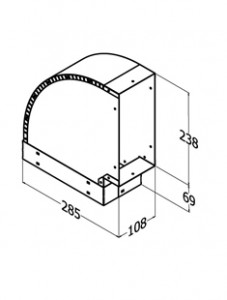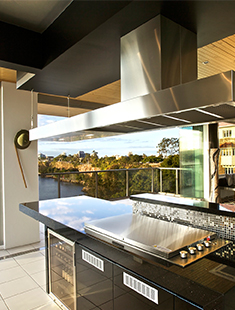IMPORTANT TO NOTE
It is very important to select the correct rangehood to suit the cooking appliances and the kitchen layout. Correct ducting of the rangehood is just as important as selecting the correct rangehood.
For all architects, interior designers, kitchen planners, builders and to anyone contemplating a new kitchen.
Important points to consider:
- The variety of cooking appliances is increasing
- The introduction of high performance semi-commercial ranges such as the Wolf cooker.
- Combinations of electric and gas cookers are now available
- Increasing popularity of
- indoor barbecues
- wok burners
- fish burners with heavy griddle plates
- deep fryers
The emissions from using of any of the appliances above will quickly fill the room with smoke, grease and odours that are difficult to remove.
CHOOSING THE RIGHT RANGEHOOD
Extraction
The type and brand of cooking appliance used with the rangehood will determine the required air movement.
In general, Condari suggests that Qasair Rangehood with two or more motors is used with the following indoor appliances or styles of cooking:
- Wok burners 15 megajoules and over
- Fish burners with a griddle plate
- Electric grillers
- Gas indoor barbecues
- Cookware over 1000 wide
- Asian and Indian cooking
Condari does not recommend using a standard Qasair rangehood over cooking appliances with a rating of >50mj. Condari will custom make a rangehood to work over these appliances.
Size
As a minimum Condari recommends that the rangehood be at least as wide as the cooker underneath to ensure maximum capture efficiency.
Qasair Rangehoods are designed for use with a standard 600mm deep bench top.
Style
We have a style of your rangehood to match your taste, kitchen space and design.
Qasair and Condor Rangehoods come in over 40 different styles including
Wall mounted canopies
Wall mounted rangehoods are canopy style rangehoods that are installed against a wall over the cooker and designed to be exposed and not built into cabinetry. The fine quality steel used to make Qasair and Condor Rangehood allow these hoods to be a stunning feature of the kitchen or alfresco area.
Island canopies
Island rangehoods are canopy style rangehoods usually designed for a kitchen that has a stove on an island bench. These rangehoods are mounted on the ceiling above the stove and are often outstanding stainless steel features of the kitchen.
Concealed / Undermount rangehoods
Concealed rangehoods are also known by the terms undermount, undercabinet, undercupboard and built-in rangehoods. These rangehoods are compact units designed to be hidden away behind cabinetry allowing seamless, uninterrupted joinery. Although discreet, these units have the same powerful motors as other Qasair and Condor Rangehoods.
Although aesthetically different, all Condari rangehoods are fitted with the same powerful motors.
Condari can also custom manufacture a rangehood for your specific requirements.
Noise
Noise levels on all models vary on high speed from 36.7db to 55db and will also depend on how the rangehood is built in.
Noise levels are measured in decibels ( db ). Condari have consulted with the CSIRO over many years on various aspects of rangehood design and performance including noise levels. Consequently, Qasair and Condor Rangehoods have the lowest noise levels even when the rangehoods are operating on maximum speed.
Condari is committed to manufacturing rangehoods that have unequalled performance whilst being increasingly quiet.
DUCTING YOUR RANGEHOOD
It is also very important to install the rangehood with the correct ducting to ensure that all the by-products of cooking are exhausted from the kitchen.
The cost to fix an incorrectly installed rangehood may be extremely expensive, especially if joinery or ducting needs to be removed and altered, so it is much better to get it right the first time.
Tips to correctly duct your rangehood:
- Always use correctly sized ducting – DO NOT reduce the size of the ducting
- Always use solid ducting
- Always use non-flammable ducting
- Always duct to the outside atmosphere
- Do not use flexible ducting
- Do not duct into the ceiling space
- Avoid sharp 90 degree bends as much as possible, use 45 degree bends instead wherever possible
- Duct to the outside atmosphere using the shortest duct run possible
- Use cylindrical ducting whenever possible









